Periodontal disease, also commonly known as gum disease, is a widespread oral health issue that affects millions of people globally. It is characterized by inflammation and infection of the tissues surrounding and supporting the teeth, including the gums, cementum, periodontal ligament, and alveolar bone. If left untreated, periodontal disease can progress from mild gingivitis to severe periodontitis, leading to tooth loss, bone destruction, and potential systemic health issues.
Understanding how to stop periodontal disease from getting worse is crucial for maintaining oral health and preventing more severe complications. This article aims to provide a detailed, subtitled, and easy-to-understand guide on managing and halting the progression of periodontal disease from a dental professional’s perspective.
Understanding Periodontal Disease Progression
Gingivitis (Early Stage)
Symptoms: Red, swollen, and bleeding gums.
Cause: Accumulation of plaque and tartar on teeth and gums.
Treatment: Good oral hygiene practices, professional cleanings, and possible antibiotic therapy.
Periodontitis (Advanced Stage)
Symptoms: Deep gum pockets, bone loss, tooth mobility, and potential tooth loss.
Cause: Progression of gingivitis due to plaque and tartar accumulation, coupled with a host immune response.
Treatment: Scaling and root planing, periodontal surgery, antibiotics, and possibly tooth extraction.
How to Stop Periodontal Disease from Getting Worse
Brushing Your Teeth Properly
Frequency: Brush your teeth at least twice a day for at least two minutes each session.
Technique: Use a soft-bristled toothbrush and place it at a 45-degree angle to the gums. Move the brush in gentle circular motions to clean the tooth surfaces and gum line effectively.
Fluoride Toothpaste: Use fluoride toothpaste, which helps strengthen tooth enamel and prevent cavities.
Flossing Daily
Importance: Flossing removes plaque and food particles from between teeth and under the gum line, areas where a toothbrush can’t reach.
Technique: Use a gentle motion to slide the floss between teeth and curve it around the base of each tooth. Avoid snapping the floss down hard between teeth, as this can irritate or damage the gums.
Using an Antiseptic Mouthwash
Purpose: Antiseptic mouthwashes can help reduce plaque and bacteria in the mouth.
Ingredients to Look For: Chlorhexidine is a commonly used ingredient in antiseptic mouthwashes that has been proven to be effective against periodontal disease-causing bacteria.
Usage: Use the mouthwash as directed on the label, typically after brushing and flossing.
Professional Dental Care
Regular Dental Check-ups and Cleanings
Frequency: Visit a dentist for a professional cleaning and check-up at least every six months.
Importance: Professional cleanings remove plaque and tartar that cannot be removed through daily oral hygiene practices. Early detection and treatment of periodontal disease can prevent it from progressing to more severe stages.
Scaling and Root Planing
Purpose: Scaling removes plaque and tartar from above and below the gum line, while root planing smooths the tooth root to remove any bacteria and promote healing.
Procedure: This procedure is typically done under local anesthesia and may require multiple visits.
Follow-up: After scaling and root planing, regular follow-up appointments are necessary to monitor the progress and ensure the disease does not recur.
Periodontal Surgery
Indications: In severe cases of periodontitis, periodontal surgery may be necessary to remove diseased tissue, reduce gum pockets, and promote bone regeneration.
Types: Common types of periodontal surgery include flap surgery, bone grafting, and guided tissue regeneration.
Recovery: Post-operative care is crucial for successful recovery and to prevent infection.
Addressing Underlying Health Issues
Control Chronic Diseases
Diabetes: Diabetics are more susceptible to periodontal disease due to their reduced ability to fight infection. Controlling blood sugar levels is essential for managing periodontal disease.
Heart Disease: Research suggests a link between periodontal disease and heart disease. Maintaining good oral hygiene can help reduce the risk of heart disease.
Quit Smoking
Impact: Smoking is a major risk factor for periodontal disease. It weakens the immune system, makes it harder for gums to heal, and increases the risk of severe periodontitis.
Quitting Methods: Seek professional help, nicotine replacement therapy, or join a support group to help quit smoking.
Lifestyle and Dietary Changes
Stress Management
Impact: Stress can exacerbate periodontal disease by weakening the immune system and making it harder for the body to fight infection.
Techniques: Practice stress-reducing techniques such as meditation, yoga, or deep-breathing exercises.
Balanced Diet
Nutrients: A balanced diet rich in vitamins and minerals, particularly vitamins C and D, calcium, and antioxidants, helps support gum health.
Avoid Sugary Foods: Limit the intake of sugary foods and drinks, which can feed the bacteria in plaque and exacerbate periodontal disease.
Hydration
Drinking plenty of water helps keep the mouth moist, dilutes acids produced by bacteria, and promotes salivation, which helps cleanse the mouth.
Conclusion
Stopping periodontal disease from getting worse requires a combination of daily oral hygiene practices, professional dental care, addressing underlying health issues, and making lifestyle and dietary changes. By following these steps, individuals can manage and halt the progression of periodontal disease, preserve their oral health, and prevent more severe complications. Remember, early detection and treatment are key to successful management of periodontal disease. Visit a dentist regularly for professional advice and care.
Related topics:

